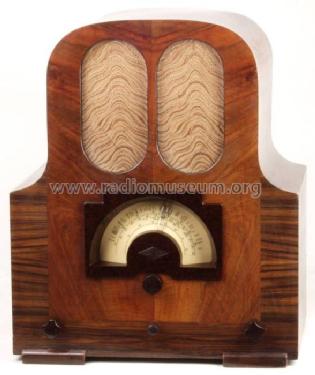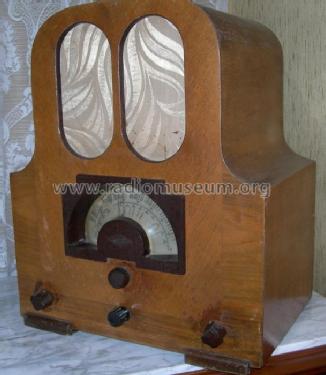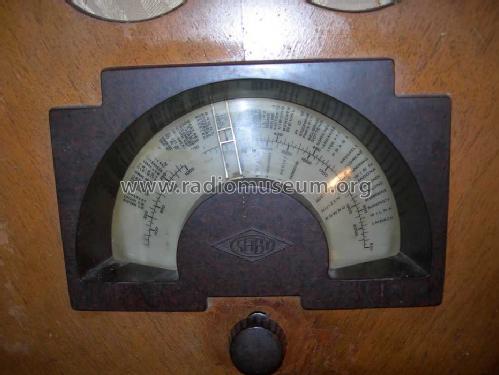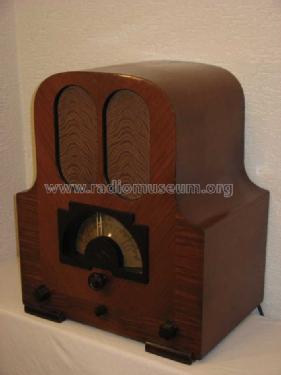Roland "Pluto" 5L 8 Kreis 7 Rö
Seibt, Dr. Georg (Nachf.); Berlin, auch München
- Country
- Germany
- Manufacturer / Brand
- Seibt, Dr. Georg (Nachf.); Berlin, auch München
- Year
- 1932/1933
- Category
- Broadcast Receiver - or past WW2 Tuner
- Radiomuseum.org ID
- 104098
Click on the schematic thumbnail to request the schematic as a free document.
- Number of Tubes
- 7
- Main principle
- Superhet with RF-stage; ZF/IF 114 kHz
- Tuned circuits
- 8 AM circuit(s)
- Wave bands
- Broadcast (MW) and Long Wave.
- Power type and voltage
- Alternating Current supply (AC) / 110 - 240 Volt
- Loudspeaker
- Electro Magnetic Dynamic LS (moving-coil with field excitation coil)
- Material
- Wooden case
- from Radiomuseum.org
- Model: Roland "Pluto" 5L [8 Kreis 7 Rö] - Seibt, Dr. Georg Nachf.;
- Shape
- Table-Cathedral-Type (upright, round top or gothic arch, not rounded edges only).
- Dimensions (WHD)
- 410 x 495 x 280 mm / 16.1 x 19.5 x 11 inch
- Notes
-
Den Seibt Roland 5 gibt es in ganz verschiedenen technischen Ausführungen (7 oder 8 Kreise, mit oder ohne AVC etc.) und zumindest mit oder ohne Lautsprecher. Der 8-Kreiser hat einen 4-Gang Drehko. Das Modell mit Lautsprecher fällt durch sein ungewöhnliches (und gewöhnungsbedürftiges) Aussehen auf (und bekam darum den Kosenamen "Pluto") - darum wohl auch die etwas spätere Variante "Spezial" mit Gehäuse des Roland 53. Der Prohaska-Katalog 1932/33 nennt ihn auf Seite 30 "Seibt-Fünfröhren-Netz-Superhet, Type Roland 5. Da sind nur die an Selektion und Verstärkung des Radiosignals direkt beteiligte Röhren inbegriffen. Die AVC-Modelle, also mit autom. Schwundausgleich, haben zusätzlich eine REN904 oder auch RE034 und alle Wechselstromgeräte ursprünglich die VG3512 (später VG240) als Gleichrichterröhre - oder eine stärkere (später VG280 oder RGN2004) wenn mit Erregung für Dyn. LS ausgerüstet. Es gibt 5-Röhren-Geräte (Gleichstrom ohne AVC) bis 7-Röhrengeräte unter der Bezeichnung "5". Dazu gibt es auch die "Type 6", ein "Sechsröhren-Netz-Super" für Gleichstrom.
Beschreibung im Prohaska-Katalog zu "Type 5" als 8-Kreiser:
Dieser Empfänger ist in seiner Wirkung noch um ein Grad erhöht und dürfte daher bald an das Optimum der erreichbaren Leistung heranreichen. Es ist nicht zu viel gesagt, dass dieses Gerät kaum noch gegen ein besseres ausgewechselt werden kann. Man hört so ziemlich alles an Stationen, was der Störspiegel zum Empfang frei gibt. Dei technische Ausrüstung ist vorbildlich. Acht Abstimmkreise, Vorsatz-Bandfilter, automatischer Röhren-Fadingausgleich. Doppel-beleucht. Senderskala je nach Wellenbereich, der 180-2000 m umfasst, Tonblende und Präzisionsteile. In Edelholzgehäuse.
- Price in first year of sale
- 290.00 RM
- Mentioned in
- Prohaska 1932/33
- Author
- Model page created by Konrad Birkner † 12.08.2014. See "Data change" for further contributors.
- Other Models
-
Here you find 416 models, 357 with images and 204 with schematics for wireless sets etc. In French: TSF for Télégraphie sans fil.
All listed radios etc. from Seibt, Dr. Georg (Nachf.); Berlin, auch München
Collections
The model Roland "Pluto" is part of the collections of the following members.
Forum contributions about this model: Seibt, Dr. Georg: Roland "Pluto" 5L
Threads: 1 | Posts: 2
Dear Colleagues,
And I respectfully repeat my original question. . . .does any member have documentation from the Seibt radio manufacturers which describes the final finish of the wood cabinets from the Roland 5 model series?? I have furniture refinishing textbooks which discuss in detail the various finishes - the original veneer on these radios is noticeably different from the post-war models.
Herr Dietmar Rich has also recently discussed the merits of using the Renuwell to restore the gloss surface of his very nice 1934 Mende. I am unable to determine the exact original finish on my 5L Spezial - the radio must have been only minimum care for MANY years.
Is there some documentation to ascertain the final surface finish of the wood cabinets within the Seibt Roland 5 models - in order to maintain authenticity as much as possible??
I have recently reviewed the EXCELLENT article by Herr Martin Renz regarding the high gloss refinishing proocedures, and he has been exceptionally thorough in all aspects.
Respectfully,
Robert
Robert Sarbell † 22.3.22, 07.Sep.06








